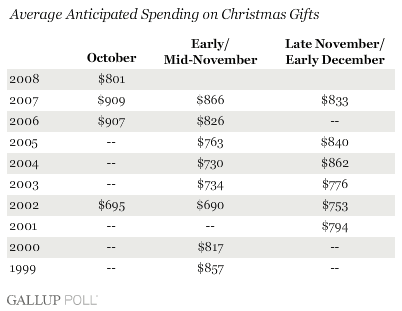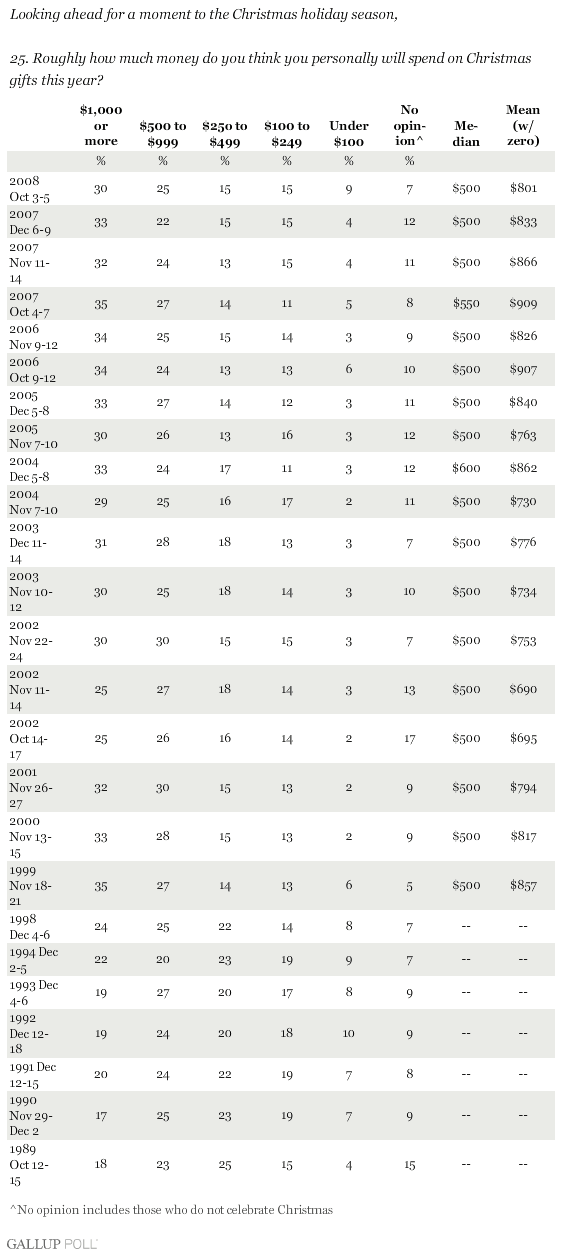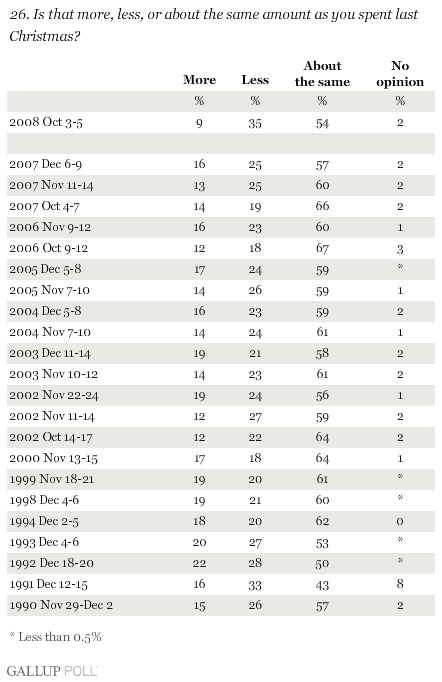PRINCETON, NJ -- A record-high 35% of Americans say they will spend less on Christmas gifts this year than what they spent in 2007. Only 9% plan to spend more.

This is based on a ���۴�ýPoll conducted Oct. 3-5. That survey started on the day the U.S. House of Representatives passed, and President Bush signed into law, a $700 billion plan to rescue distressed financial institutions, and before much of the slide in the U.S. stock market seen this month, but .
���۴�ýtrends on this question since 1990 show that Americans are typically conservative in their spending plans, with more saying they will spend less money on Christmas gifts than the year before, rather than more money. (The majority tend to say they will spend the same amount, as do 54% this year.) However, this year's more-spending-to-less-spending ratio is by far the most inauspicious ���۴�ýhas seen for the nation's retailers.
Until now, the worst Christmas spending outlook in ���۴�ýrecords was in late November/early December 1991 (the first Christmas season after the 1990-1991 recession), when 33% of Americans said they would spend less on gifts than the year before and only 16% said they would spend more.
More recently, a November 2002 ���۴�ýPoll found 27% of Americans saying they would spend less on gifts, and only 12% saying they would spend more. That year, December consumer retail spending rose by a mere 1.4% over December of the previous year -- one of the worst holiday retail seasons on record in the past 15 years. (According to the Census Bureau's "GAFO" measure of department store-type retail sales for December of each year since 1993, an annual increase of 5% in spending is about the norm.)
All of this suggests that the disappointingly weak holiday retail sales seen in 2007 -- with a mere 1.7% annual increase in retail spending for December 2007 -- could be even worse in 2008.
Spending Forecast
Another sign that consumers will temper their usual holiday spending comes from Americans' estimates of the total amount of money they will spend on Christmas gifts this year. According to the Oct. 3-5 poll, the average amount Americans think they will spend this year is now $801, roughly $100 lower than the average amount Americans estimated last October that they would spend in 2007.
The current figure is higher than the average $695 estimated in October 2002, but in inflation-adjusted dollars, the $695 in 2002 would be $845 today. Thus, today's spending projection of $801 is slightly lower than what ���۴�ýfound in 2002, itself a highly anemic holiday retail season.
Americans' estimate of the total amount they will spend on gifts often changes as the holiday season progresses. In each of the past two years, the average estimate ���۴�ýrecorded in mid-October fell by mid-November; in other years, consumers' average estimate of what they would spend increased closer to the holiday.

Bottom Line
As of early October, a time of extraordinarily weak consumer confidence and economic uncertainty, Americans were already exhibiting much caution in their holiday spending plans. A mid-October ���۴�ýsurvey found -- a figure not likely to have been much better at the start of the month.
The degree to which the U.S. economy is perceived as either improving or falling further off the tracks in the next two months will be an important factor in how Americans perceive their own financial situations, and in how the holiday retail season ultimately plays out.
���۴�ýwill update Americans' Christmas spending intentions in November, and again in early December.
Survey Methods
Results are based on telephone interviews with 1,011 national adults, aged 18 and older, conducted Oct. 3-5, 2008. For results based on the total sample of national adults, one can say with 95% confidence that the maximum margin of sampling error is ±3 percentage points.
Interviews are conducted with respondents on land-line telephones (for respondents with a land-line telephone) and cellular phones (for respondents who are cell-phone only).
In addition to sampling error, question wording and practical difficulties in conducting surveys can introduce error or bias into the findings of public opinion polls.


